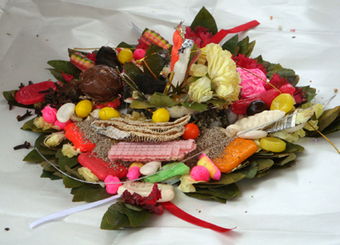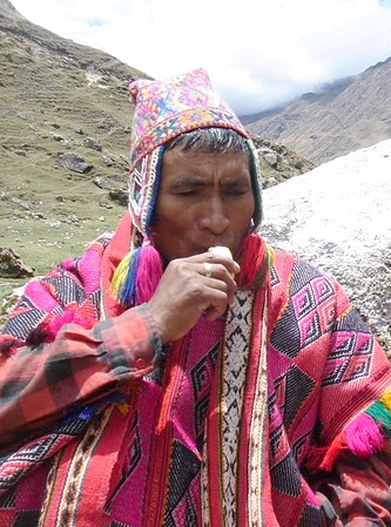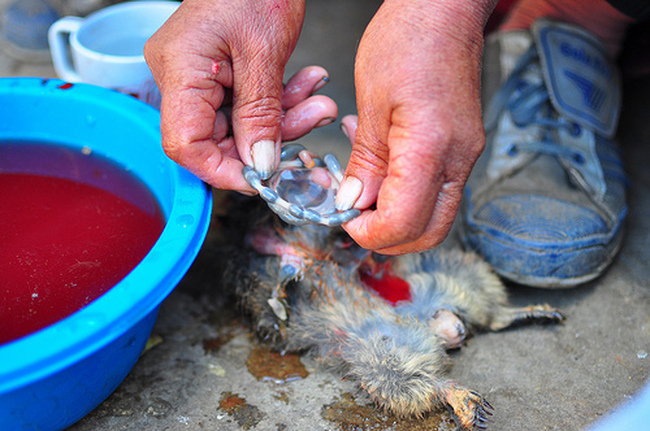Medicinal Practices in the Peruvian Andes
Just like plant and herbal medicine, there are countless medicinal practices used by healers in the Peruvian Andes. They differ slightly between regions, but there is a sense of continuity, as well. In this section I will describe two of the most common practices, both of which I experienced in one way or another while in Peru: the despacho and the shoqma.
El Despacho

Example of a "despacho" (steppingintofreedom.com)
There are a number of practices that Andean healers undertake. One such practice is called "despacho" ("shipment"). The despacho is a small kit made up by a curandero specifically for a particular person. He or she tailors it to the needs of that person, depending on the symptoms and illness. This kit often has coca leaves, other herbs, and small "gifts" like wine, sugar, or flowers. It is essentially an offering to the apus (mountain deities) and Pachamama (Mother Earth) for healing and protection. These thoughts are part of the Andean conception of nature, which is very similar to many North American native groups who worship nature and entreat the gods/goddesses for help. There are quite a few types of despachos, but they always relate the human suffering, requests, and thanksgiving with the cosmological.
In the despacho ceremony, the curandero packages the offering, taking great care in doing so. He or she then rubs the package over the patient's body while chanting for favor from the apus. After the prayers and energies have been drawn out of the patient's body, the curandero burns the despacho. The smoke carries those prayers and issues to the apus, where they will hopefully take heed and lend protection and healing (18).
In the despacho ceremony, the curandero packages the offering, taking great care in doing so. He or she then rubs the package over the patient's body while chanting for favor from the apus. After the prayers and energies have been drawn out of the patient's body, the curandero burns the despacho. The smoke carries those prayers and issues to the apus, where they will hopefully take heed and lend protection and healing (18).
The Shoqma

Traditional Andean curandero (steppingintofreedom.com)
Another of the more popular medicinal practices is the shoqma (also called soba). This is a traditional practice done by healers in the Andes, generally using a cuy (guinea pig), but occasionally with flowers or other materials. It is a diagnostic tool in which the healer or curandero rubs the animal or material over the patient's body and then analyzes the body of the guinea pig (or other material) to see what is wrong with the patient.
The guinea pig is most often used in this procedure, and it is one of the most important parts of Andean life. Being one of the few domesticated animals native to the area, the cuy is an animal that is used as food, as well as for medicinal and spiritual practices (16). In the shoqma/soba de cuy, the healer/curandero takes the patient into a back room and rubs the animal over his or her body while chanting prayers. The guinea pig absorbs the energies from the patient's body during the process. Oftentimes the healer prefers a black or dark-colored cuy for the practice because they are believed to have greater spiritual and healing powers. The analysis is handled in different ways in different areas of the Andes: sometimes the guinea pig is left alive and analyzed, but more frequently the healer slits the guinea pig's throat. Then he or she cuts the cuy open and analyzes its organs, blood, and bones to diagnose the patient. Following the ceremony the cuy assumes the identity of the patient and allows for the curandero to link its body with the patient's. The diagnostic can include anything from mental health to problems with organs to parasites to excessive heat/cold in the body (a traditional Andean health concept).
The healer gives suggestions for treatment for his or her patients and can often offer up herbal knowledge for possible solutions. There is also quite frequently a spiritual aspect that the curandero mentions. Because a large portion of Andean conceptions of health relate to maintaining balance and social relations, the healers attempt to reconcile outside issues to heal the body (21).
The guinea pig is most often used in this procedure, and it is one of the most important parts of Andean life. Being one of the few domesticated animals native to the area, the cuy is an animal that is used as food, as well as for medicinal and spiritual practices (16). In the shoqma/soba de cuy, the healer/curandero takes the patient into a back room and rubs the animal over his or her body while chanting prayers. The guinea pig absorbs the energies from the patient's body during the process. Oftentimes the healer prefers a black or dark-colored cuy for the practice because they are believed to have greater spiritual and healing powers. The analysis is handled in different ways in different areas of the Andes: sometimes the guinea pig is left alive and analyzed, but more frequently the healer slits the guinea pig's throat. Then he or she cuts the cuy open and analyzes its organs, blood, and bones to diagnose the patient. Following the ceremony the cuy assumes the identity of the patient and allows for the curandero to link its body with the patient's. The diagnostic can include anything from mental health to problems with organs to parasites to excessive heat/cold in the body (a traditional Andean health concept).
The healer gives suggestions for treatment for his or her patients and can often offer up herbal knowledge for possible solutions. There is also quite frequently a spiritual aspect that the curandero mentions. Because a large portion of Andean conceptions of health relate to maintaining balance and social relations, the healers attempt to reconcile outside issues to heal the body (21).
Next: Experiencia Personal

